Story – Chris Hector & Photos – Roz Neave and Kit Houghton
Mary King is a phenomenon, seemingly ageless, she produces horse after horse and keeps on winning the world’s biggest, toughest three-day events. Mary rode in her first Badminton in 1985 at the age of 24, and finished seventh on Divers Rock. Seven years later, she won Badminton on the great King William, and she was back again to win it on Star Appeal in 2000. She has been the British Open Champion three times, won Burghley in 1996 on Star Appeal, and competed at six Olympic Games from 1992 to 2012.
WOW!
Badminton Horse Trials, 1995, with King William
And yet, Mary describes herself as ‘not a natural rider’ and is certainly not obviously a superstar stylist in the mould of Ingrid Klimke. She is just a very professional, dedicated rider with an enormous will to win, an infectious grin and a wicked sense of humour. With an amazing ability to adapt as the sport changes and evolves, she is also fun to interview…
There have been huge changes in eventing – the role of dressage, the kind of cross-country course, the degree of difficulty in the showjumping – but one person just keeps on winning no matter what they do to the format… you! No one else has done that – what’s the secret?
“I just love being involved with horses and eventing. It has changed enormously from when I very first started, some of the changes are good things, some not so good, but it is still such a great sport, it’s really exciting and I love it.”
Badminton Horse Trials, 1991, Mary Thomson (Mary King) with King William
But there must be something about the way you operate that makes you very flexible. I remember when flying changes came into the dressage test, seeing you at Badminton and you did lovely little simples, but now your dressage is very classy…
“Time has moved on, and you need to accept that it has moved on. I am constantly training, trying to learn more. I go off and have lessons, I love having lessons from people I respect. I enjoy criticism as in constructive criticism, and I suppose because I am very open to that, I have been able to move on as the sport has changed.”
Would you describe yourself as a theoretical rider or are you a feel / seat-of-the-pants rider?
“To begin with as a young person learning to ride, it didn’t come naturally to me at all. It took me a whole year to learn how to do rising trot, people usually master that after a couple of lessons. It has taken me a long time to adjust to each new thing, I can’t say I was a natural rider, but I have always wanted to learn, always wanted to be at the top level, and competitive – I do like winning!”
You are a winner aren’t you? There are a lot of riders who have one great horse, two if they are lucky, but you seem to produce one after another after another…
“I have been very lucky over the years to have had some wonderful horses. Quite different types of horses but I managed to produce them to that top 4 Star level and have success at that level with them. I think a lot of my success goes back to the time when I spent three years with Sheila Willcox. I feel that a lot of young riders miss out on forming a base, and in my time with her, I formed a very broad base for me to build my career on. Because I have such a broad base, I have a lot to build on, lots of riders start with a much narrower base and so many seem to get to a certain level and then they are unable to get any higher. She was a very, very strict lady, everything, not only the riding of the horses but the stable management, the care of the horses, feeding, grooming, fittening, working the horse, it was so strict. I do things now quite differently from how Sheila did them but there is a huge amount that I have taken from my time with her, and without that broad base, I couldn’t have got to the top.”
It’s amazing, when I talked to Carl Hester in the lead up to Greenwich, and asked about the influences – and he said, ‘Sheila Willcox via Dr B’ [Dr Wilfried Bechtolsheimer, whose daughter Laura rode in the British dressage team at the London Games] Carl was working for Dr B at the beginning of his dressage career, and that’s where he came across Ms Willcox…
“That’s right. I remember Dr B coming to Sheila’s yard, because I was a little 16-year-old girl, working away in the yard. It was when Dr B very first came to England, he went to Sheila’s yard. He stayed in a local hotel during his time with us, and he used to come riding up on his little moped – put, put, put – with his riding hat on, that was illegal but he just did it, and he used to go backwards and forward each day on his little moped, coming to Sheila’s to learn.”
What an extraordinary influence she had – what an amazing person Sheila Willcox must have been…
“Absolutely, she was one of the first women to compete internationally. It used to be very male dominated, all Army influence, and she was one of the first females to come in and prove we could do it as well as the boys.”
Then you proved that you can have children and still go on and event – because that was another belief that was around the place – once you had a child you couldn’t ride cross country…
“That’s right. When people heard I was pregnant, they said wait until you have your baby, you won’t want to do it any more, you’ll lose that competitive spirit. And I thought, well I don’t know if I will, I’ll have to wait and see – but no it didn’t affect me at all. I was galloping along at my first event after Emily’s birth, and there she was in a pram with my Mum, and I thought ‘no, it doesn’t feel any different’. I was lucky I had horses that were at the top level at the time, horses that still had years ahead of them, and I knew those horses inside out. I just had a few weeks off to have my baby, then got back on again!”
Your horses are always really quality horses – do you go on breeding or type, how do you find these wonderful horses?
“I’ve never really followed any breeding patterns. A Thoroughbred is the base, but the horses I’ve had the most success with have not been full Thoroughbred, more 7/8ths – Thoroughbred with a bit of Irish Draught, that would be King William, Star Appeal, those horses all had a little Irish Draught. Now with Call Again Cavalier and Imperial Cavalier, they are from Cavalier Royale, Holsteiner.”
Punchestown Horse Trials, 1995, Star Appeal
But a Holsteiner with a lot of Thoroughbred blood…
“Exactly. For 4 Star level, the Thoroughbred is still the basis of success. If you notice, the foreign horses might get up to 4 Star level, they might do well once or twice but they don’t stay like the Thoroughbreds. King William, Star Appeal, they did those long format 4 stars one after another after another, year after year and they would stay sound and tough.”
“Conformation-wise those Warmblood horses are not built to gallop through long distances at speed, they often have soundness problems – they might want to do it, they might have the heart, but they are not built to run those long distances.”
Do you have mega-rich owners trailing behind you with their cheque books, to buy your lovely horses?
“All the horses I ride are owned by other people, I don’t own any myself, although I have bred a few over the past couple of years, that have gone on to a top level but I have sold all of them. Like King’s Temptress, she was my reserve horse for the Olympics, I bred her and then when she was seven years old, sold her to a gentleman who wanted to own an event horse but he needed a rider – so I kept the ride on the horse and had the best of both worlds. I am reliant on owners and sponsors.”
Is that increasingly hard, the price of a good event horse is a lot more than it used to be?
“Yes, but I mainly produce them from young horses. Eddie and Sue Davis own Imperial Cavalier and they did own Call Again Cavalier, and they bought both those horses at 3 Star level, so they paid big money, and I was the lucky rider who got to produce their horses for them. The majority of the horses that I have taken to 4 star over the years, I’ve found as four or five-year-olds, so they are not expensive – and I’ve then produced them myself for the owners.”
Imperial Cavalier, 8th in Kentucky at the 2010 WEG
You’ve survived the introduction of the flying change, you’ve survived motherhood, is there anything that suggests that one day you might call it quits?
“I’ve been fortunate enough to have ridden at six Olympic Games, I’ve won a bronze medal in Beijing, silver medal in Athens, I was hoping for gold in London to complete the set but we won silver – which was fantastic at a home Games – but now I have to keep going for another four years because I want to get that gold one…”
So Brazil it is?
“That’s the aim.”
And you don’t find it hard to fire up again, there aren’t mornings when you think, I’d rather stay in bed?
“No. I’ve always had quite a small yard. I don’t ride many horses, and I think that is what keeps my interest up. The last few years I’ve had a maximum of six horses. I take my hat off to someone like Andrew Nicholson, he is the same age as I am, and he has so many horses, and he is on the road all the time. He’s amazing. I’ve got an easy life really. I focus on a few horses, and always at this time of the year – November/December – I don’t ride at all. The horses have a complete holiday, I do more family things, focus on David my husband, and my children, then when all the horses come back in, in January, it is so exciting every year. ‘Oooh the horses are back in!’ And the girls come back to work for me, and we start up again – another exciting year. When it comes around to October, and the end, I think great, end of the season, and I am quite happy not to ride for a couple of months.”
“I think riders who plug on all year, that must be tough. Maybe my breaks keep it exciting.”
Do you think you have ridden the horse that will take you to Rio?
“I have got a couple of very nice horses in my yard, owned again by the Davis’s, one’s a six-year-old, one seven. I think the seven-year-old is the most likely horse, he is called MHS King Joules – he’s an Irish horse. Right now he is an intermediate, 2 Star level. He is out of a mare by Cavalier Royale, and his father is the Thoroughbred, Ghareeb. He’s quite a ‘blood’ horse, he’s a very good mover, he jumps well, he is very sharp, he just needs gradual calm producing so he gets totally confident in himself. His ability is great, he is bold and brave, he just needs to try and keep calm as he goes up through the levels.”
Equitana Masterclass
One of the things I ‘love’ about Equitana, is that the organisers are so hopelessly inept. The Mary King Master Class was due to begin at 2.30pm, but the horses and riders aren’t ready, so the one hour session starts quarter of an hour late. Still the good sized crowd has come well armed with large quantities of smelly fast food, and seem happy to sit in the sun and cuddle their shopping bags.
Mary is mounted on that wonderful old (he’s 20 now) trooper, GV Top of the Line. Carlo was a star with Olivia Bunn: they were seventh in the WEG at Jerez, fourth at the World Cup Final in Malmo, placed at Adelaide 4*, Rolex Kentucky 4* and Badminton 4*. He still seems to be enjoying life and keeps Mary’s mind on the job as she breezes him around the arena.
Mary and Carlo are going for a canter
Mary’s message is the kind of practical, common sense wisdom you might expect from one of the world’s greatest eventers. If you’ve seen Mary in action, she is one of the great exponents of the nineteenth century hunting seat, but as she remarks, it is a good idea not to fall off:
“At the London Olympic Games there were at least two riders who fell who shouldn’t have fallen. Your position is the most important thing in cross-country riding, and really you shouldn’t come off unless your horse falls. The more secure you are in the saddle, the quieter and softer you will be.”
Lauren and Arabian Nights over the vertical
Mary had her two first customers, Fiona Hawkes and Isle of Tatiana and Lauren Hill and Arabian Nights, circling her in cross-country position:
“Get out of the saddle, just touching with each stride, not sitting hard and uncomfortable, nice and light and soft in the saddle and close to the horse…”
(And young riders note: it is not necessary to copy Ms King’s dramatic right/left hip swivel, the lady is a one-off and it is better to do as she says than as she does.)
“The next most important thing is lower leg position. Fiona, your toe is sticking out, try to straighten your foot to a nice parallel position – this will also stop your spur sticking into the horse.”
Longer strides, the horse is more open
“The next most important element of cross country riding is speed. The horse has no idea of what speed it needs for what fence. Some fences need the horse condensed, some need the horse more open. When you want to slow the horse, move your shoulders back and then close your hands. The horse is much more likely to pull if you try to slow him with your shoulders forward. Tuck your tail and pelvis forward, then you can gallop with your shoulders upright.”
Shorter strides, the shoulders are back, the horse is listening to the rider
Mary wanted to demonstrate that you could practise cross country jumps at home, without a lot of fancy equipment or fences: “I want you to jump this pretend coffin, oops, we aren’t allowed to call them coffins any more – rail/ditch/rail. You don’t need a cross-country course at home. I don’t have a cross-country course at home – I use the natural surroundings. Ride up and down hills, through the forest, through the river, gradually build up confidence and trust. You want to form a partnership, you trust him, and he trusts you and you must never abuse that trust.”
“You need to get them used to ditches as young horses. At home, I use feed bags, lay them out in a line and secure them with poles. Keep on asking until they leap, and repeat over and over, until they come in a nice soft way and pop. If they come in a stop, you must insist that they eventually leap, make sure they get over the first time.”
“I do lots of playing at ditches at home. There’s a stream in our valley that creates nice ditches and I spend a lot of time popping over that. It’s amazing what a wide ditch they can jump out of a quiet trot.”
Fiona jumping over the ditch
“After the horse is jumping the ditch, jump a little fence after the ditch. It’s must spookier for them to jump a fence before a ditch. Once they get used to the ditch, then ditch to rail, then when they are confident with that, rail to ditch.”
“They rely on us to bring them into the fence in a correct canter and to make it easy for them. When you condense them, don’t think slow, think condense, a shorter stride pattern and more athletic, not slower and slacker.”
“Our horses must learn to listen to the rider. You can’t have them fighting to go fast, they must be smooth and quiet – look at William Fox-Pitt or Mark Todd, it all looks effortless even over a big 4 Star track. The more the horse enjoys it, the more confident they are going to stay.”
Not surprisingly, Mary was running short of time, and the next twosome were ushered into the ring – Rachel Lee and Baileau and Edith Kane and Serious Business – and this time it was that all-time favourite exercise of intelligent jumping instructors the world over: adjust the strides between the fences. They are to do it in five strides, and ‘Carlo’ and Mary show how easily this is done. Now do it in four: “This makes you effective as a rider, and teaches the horse to listen and quietly accept what you are asking. Now change direction and do it in five this time…”
Practicing the skinny
The next exercise was the dreaded skinny…
“Narrow fences are unnerving to them because they are used to 12 foot wide showjumps. I like to go into a competition knowing I can jump everything, then the horse goes to the next competition in a good frame of mind. You can test them at home, challenge them at home, but use the competition as the confirmation of the preparation.”
Mary enjoyed her time in Australia
It is once again a familiar scenario. Start with some poles either side to funnel the horse over the jump and come in at the right canter: “You want a condensed stride but not strangling the horse, it is easy to get too controlled and then the horse doesn’t know where to go. Both of you are a bit forward over a fence, if you dive forward at the last minute you take your weight from behind the shoulder to over the shoulder… the angle of the gap between your horse’s neck and your body makes enough of a fold.”
Mary finished her session with Will Enzinger and Aquifer and John Twomey and Highly Recommended. This time Mary started with an exercise – pole / vertical / pole / oxer – to get the horses to back off a little and make a better shape. “Some horses just can’t jump in a perfect style, all you can do is try and get them as good as you can. When I started riding King’s Temptress as a four-year-old she was very flat backed and difficult to jump… great, and I bred her! But she progressed and strengthened and developed her own way of jumping high fences and ended up winning Kentucky 4 Star. The lesson is to give them a chance, give them more exercises to give them confidence in themselves.”
Once again it was the lesson of a consummate professional, it even made Equitana worth coming to.
Post-lesson feedback with Will and John

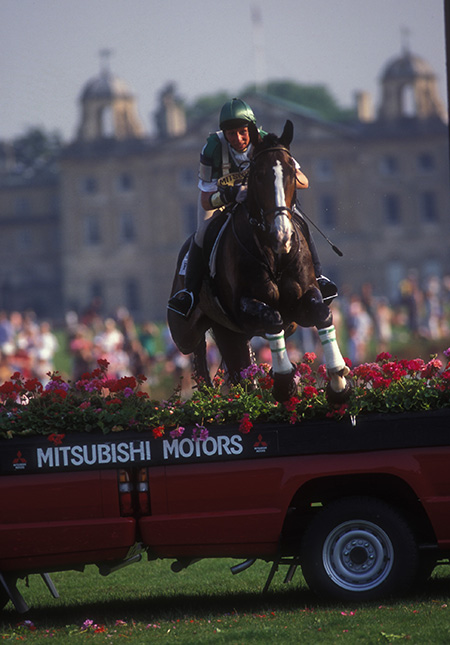
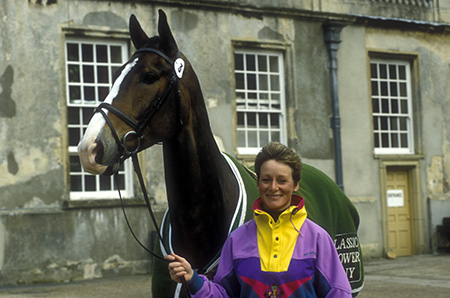
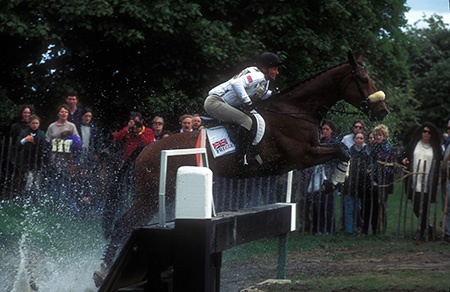
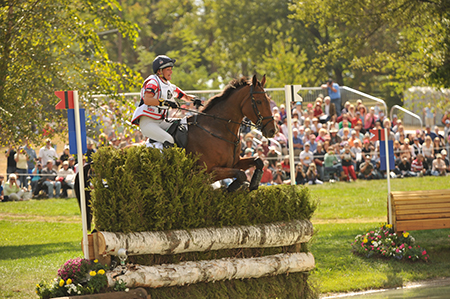
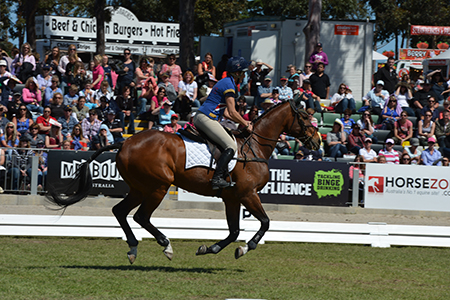
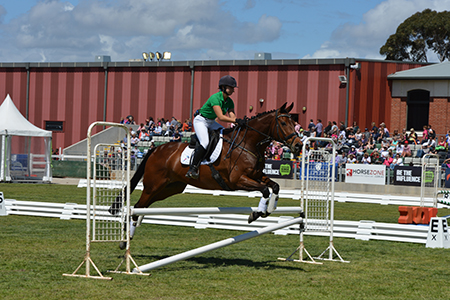
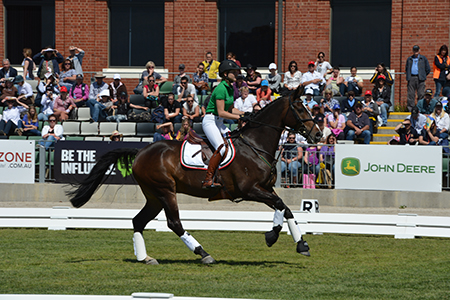
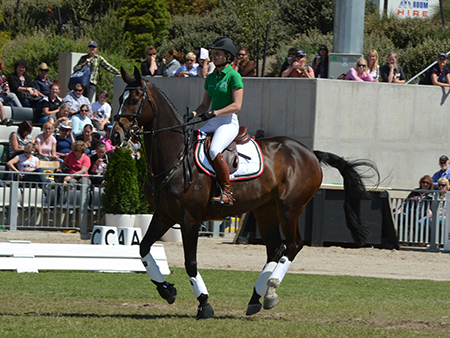
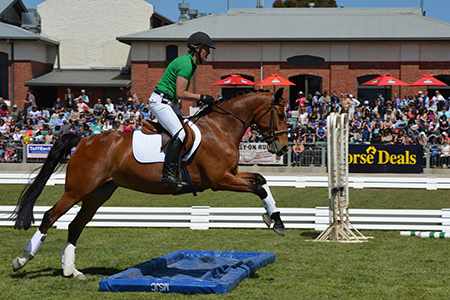
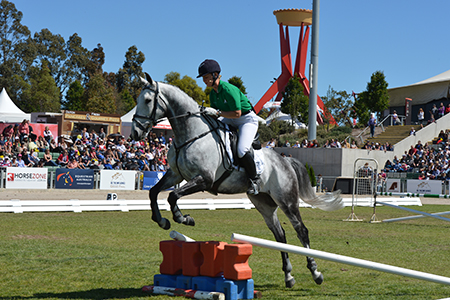
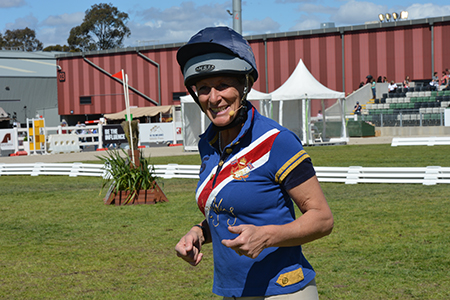
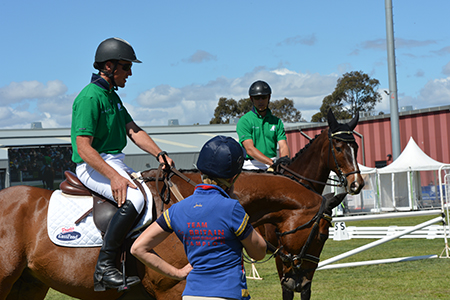
amazing